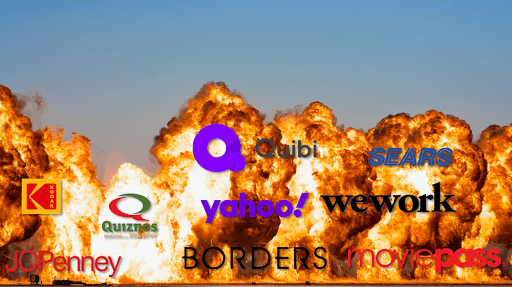
Apple, Amazon, Tesla… We like to prostrate ourselves to the altar of innovation. So much so, that we tend to forget that just one catastrophically bad strategic decision might bring these companies down. It’s happened before, and it will keep happening.
After years of leading innovation workshops, I’ve put together a small guide listing the biggest business failures in the corporate world over the past few decades, and what we can learn from them. There won’t be any reference to Blockbuster in this article, at this point, it’s like shooting fish in a barrel.
Quibi

The failure
Quibi shut down in late 2020, a mere six months after launching its streaming service. It had raised $1.7B. That’s a short, expensive life for a company which claimed it would revolutionize how people consume entertainment.
Its objective was simple: turning Youtube videos into television. More specifically, creating 10-minute clips that would be watched on mobile, in portrait mode during commutes.
What went wrong? First, pricing. Youtube and TikTok are free, and few customers were willing to pay for smartphone-only content. Then, the pandemic. Right after the launch of the app, many people stopped commuting and had much more time at home to watch content on a bigger screen. Not great for 'transit entertainment'. The offer also wasn’t what mobile users wanted: it relied on A-listers instead of the Youtubers or TikTokers people were used to watching on the go. Viewers couldn’t even take screenshots to post on social media, making it tougher to generate a buzz. Finally, and perhaps most importantly, management was not up to par. Quibi’s CEO, Meg Whitman is not an entertainment startup CEO, having led HP for 6 years. The founder, Jeffrey Katzenberg, is also a dinosaur of another era and was said to be far too arrogant for the good of the company.
The lesson
Quibi’s failure is one of self-sabotage. Its core concept isn’t inherently bad. The company however relied on ego more than talent to create it. They also went too big, too fast, and were caught up by the unexpected, as we so often are.
Their pricing decisions were equally awful. They may have saved the house by adding adverts to content and making the app free. But then they wouldn’t have attracted the celebrities they wanted, and the large funding they secured. Not that either was necessary…
Lesson #1: Build the right team (not the best team), set the right price… and expect the unexpected.
MoviePass

The failure
The cinema industry is ripe for disruption. Created in 2011, MoviePass claimed to be THE solution. Their logic was simple (and too good to be true). Offering a subscription to view a movie per day, anytime, anywhere.
For years, the cost of the subscription was $50, and MoviePass struggled to make ends meet. Its bet was that people who viewed very little would offset the costs of those viewing a lot — like gyms. But most people hate going to the gym, and most people like going to the movies. Hardly any customers only saw one movie in a month.
In 2017, Helios and Matheson Analytics essentially bought MoviePass, fired its founder, and lowered the price of a monthly subscription to 10$. As they were buying tickets at the list price, this meant they lost money from every subscriber. But, in theory, they were creating a base to negotiate with movie theatres.
They bet they could bargain with movie theatres and get A) discounted tickets and B) a cut of concession sales (where the real money is, and which they would have increased). Should that plan have worked out, MoviePass would have become a major player in Hollywood’s ecosystem. But AMC Theatres, bothered by these aggressive tactics, refused to participate. Instead, they launched their own subscription service. Moats. You need them.
It all went downhill from there. The company shut down in 2019, and is now remembered mostly as a cautionary tale.
The lesson
MoviePass got in bed with the wrong people not once, but twice. First, raising money from Helios & Matheson, which got their founder fired. Then, acting out an abusive relationship with AMC Theatres saw the launch of direct competitors. The company also neglected its customers with half a dozen of opaque, poorly planned, and executed initiatives.
That’s a lot of arrogance for a company that offers no innovation other than cheaper movie-going options. In the end, they were reminded of their place by the massive Hollywood industry, which few can bend to their will. Who knows what might have happened if they’d been kinder to AMC, or if they’d held on long enough to see COVID shut down theatres for months?
For the record, I still think there’s a way to make movies work: charging 100$ per ticket.
Lesson #2: Take care of your ecosystem and your ecosystem will take care of you.
Yahoo!

The failure
In 1998, Yahoo refused to buy Google for $1 million. Four years later, realizing their mistake, Yahoo offered to buy Google for $3 billion, but Google asked for $5 billion, or 0.5% of its value today (adjusted for inflation). Yahoo refused.
In 2006, Yahoo was supposed to buy Facebook for $1.1 billion. As Facebook only had $20 million in revenues at the time, Yahoo!’s CEO lowered the offer to $800 million and Facebook backed out.
In 2008, Microsoft offered to buy Yahoo for $44.6 billion, but Yahoo turned them down. This was met with a barrage of criticisms; the 2008 financial crisis had made easy money hard to come by.
In 2016, Verizon bought Yahoo for $4.6 billion. Its revenues had by then fallen by 20% from its 2014 highs. Yahoo had successfully bought Tumblr for $1.1 billion a few years prior. In 2019, Verizon sold Tumblr for 3 million, 0.27% of what it had been valued as.
The lesson
The story of Yahoo is first and foremost a tale of M&A and ego. Companies should know when to make, buy and/or partner. Yahoo continuously took the wrong decisions in that regard, trying to ‘make’ when it clearly didn’t have the capabilities to do so.
The company had 6 CEOs in the span of 20 years. When Yahoo made acquisitions, they were often ego purchases from CEOs looking for quick results. This meant they were likely to panic and behave erratically when faced with an outside crisis, like the dot-com bubble or the 2008 crash. This, in part, explains why Yahoo was never able to decide if it was a media or a tech company while losing talent and ad sales to Facebook and Google.
Lesson #3: Hold a study course in the storm, cash out in fair weather.
Kodak

The failure
Created in the 1890s, the company actually invented the first digital camera in 1975, but then held back instead of using this new technology. Kodak was afraid of hurting its lucrative film business, even as digital products were reshaping the market.
Through the years, the company tried to diversify as a way to avoid embracing change. It dabbled in chemicals and healthcare, acquiring companies through high debt… only to sell them far too early.
The company started to turn around in the mid-00s but failed to see how much digital cameras would become cheap commodities. It also failed to assess the seismic change that smartphones would bring about. Few did. It focused on digital photography and digital printing and attempted to generate revenues through aggressive patent litigation. too little, too late. Kodak filed for bankruptcy in 2012.
The lesson
Kodak made two critical mistakes. First and foremost, it lived in a museum, crippled by nostalgia. Its entire structure was reliant on past glory which kept it from capitalizing on digital wins. That part is easy to see.
Secondly, the company DID have a lot of good assets it could use. Kodak was however prone to abandoning new projects too quickly and spreading its digital investments far too broadly. Kodak was good at research and patenting, but terrible at commercializing its products. It’s likely this was more of a factor in its downfall, than its failure to adapt quickly to changing markets.
Lesson #4: Adapt according to your strengths.
Sears

The failure
For over 100 years, Sears sold everything from socks to tires via mail order, shipping all over the US.
In theory, Sears was well placed to beat Amazon fair and square. Hell, it was Amazon. It partnered with IBM in 1984 to create one of the first proto ISPs and offered online services such as message boards and emails (but no eCommerce) years before the WorldWideWeb was invented. It also created its own credit card to rival MasterCard / Visa in 1985 and had its own insurance company.
In practice, however, Amazon is not an eCommerce company. It’s a supply chain company. While, Sears had a mail-order catalogue, brick-and-mortar shops, and great name recognition, its infrastructure was slow. To survive in the digital world, they needed to rebuild or get rid of it. They chose the latter. The company ended its catalogue/delivery business in 1993 (firing 50,000 workers in the process). Amazon was founded in 1994.
What followed for Sears was a long and expensive death. It fought simultaneously big discount giants such as Walmart and the eCommerce giants such as Amazon. It could only end one way. Sears filed for bankruptcy in 2018.
The lesson
In a different timeline, we would now be hearing news about the government wanting to break Sears up for anti-competitive behaviour. That news may very well have been hosted on an IBM/Sears/prodigy cloud platform server.
But Sears forgot that remaining competitive is, by definition, hard work. When faced with their immense technological and cultural debt, they chose the easy way out and as a result, were doomed. Vision isn’t enough — you also need the will to do the boring stuff well, and with continuity.
Lesson #5: When at the top, you need to work twice as hard.
JCPenney

The failure
Founded in 1902, JC Penney offers a fascinating marketing case study. By the early 2000s, they were struggling to compete with more modern retailers. Instead of emulating its successful competitors it… tried everything else (?).
First, they cut all the sales, and sold everything for ‘cost plus retail markup’. Then, they removed brands that sold below a certain threshold from their stores and introduced higher-priced brands. They also ended coupons and clearance sales. Finally, the changed their logo and store design. The reasoning was that they would attract more wealthy customers.
Not only did this not work, but it alienated the company’s customer base. They saw empty stores with no deals and people stopped shopping there entirely. On May 15, 2020, JC Penney filed for Chapter 11 bankruptcy. But hey, at least, its CEO got a fat paycheck on his way out.
The lesson
Marketing isn’t a science. It’s an art. For many customers, JC Penney was where you got good deals, because everything was advertised that way. Customers were used to the coupons and the regular promotions. When it went away, so did they.
Yes, retail sales are often fake, and JC Penney was trying a more honest approach to retail. But some customers want to be lied to. And that’s OK — you have to give your customers what they want.
Lesson #6: Know who your customers are… and what they want.
Borders Group

The failure
Borders could have become Amazon, but it turned down the opportunity. Blame the dot-com bubble… and frail nerves.
Before becoming the giant we know today, Amazon.com was a small online retailer among many. In the early 2000s, it had potential, but little else, plagued as it was by an incompetent search engine (still the case today), misclassified titles, and diversification struggles. Borders was also struggling, suffering from its lack of digital capabilities, having failed to make its own efforts in the space profitable.
A partnership seemed to make sense. Borders contacted Amazon and asked them to build an online inventory, a web-storefront, and a sales management system. Amazon got some free marketing in exchange. When the dot-com bust, Borders got spooked and wanted out. In 2007, Borders ended its alliance with Amazon. By then, Amazon had begun using the system it built for Borders. Legend has it that the system was better than what Amazon was previously using.
The rest is history, for Borders and many other bookstores. In 2011, the company filed for bankruptcy, closing 399 stores and laying off 10,700 employees.
The lesson
This, too, is a make/buy/ partner lesson. While Borders made many strategic mistakes in its last decade (too many locations, too much debt, late on ebooks), outsourcing its online book-selling to Amazon.com cut its customer base and future potential. The company should have taken advantage of Amazon, then ditched it once it was more secure in its capabilities.
Borders could have also reworked its deal with Amazon, instead of trying to go at it alone when it became clear that the existing partnership no longer benefitted them.
Lesson #7: Keep your friends close, and your enemies closer.
Business model innovation is not easy. If these 7 examples teach us anything, it’s that outside forces will always have a bigger impact than expected. What entrepreneurs and CEOs should do, however, is leave their egos aside and be constant learners.
Only then can they survive.
Good luck out there.


